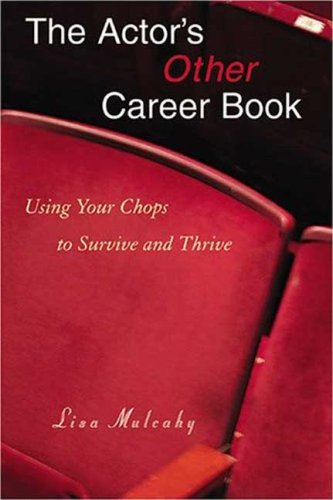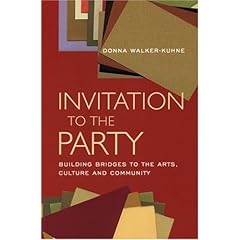


I ran across Lisa Mulcahy's 2006 book
The Actor's Other Career Book: Using Your Chops to Survive and Thrive at my university's library, and I grabbed

it with great relief. As any of you who have followed this blog in the past know, one of the ideas that is part of the theatre tribe model is that the tribe coordinated the ancillary income, of what I call "
And Then." This idea is that theatre artists have many talents and skills that are valuable, and that it is wiser for the tribe to receive the benefit of those skills and talents instead of outside employers. Mulcahy had the same idea.
Her book is really a testimony to the work of the
Actors Work Program, which is part of the Actor's Fund. According to the AWP website:
The Actors Fund’s Actors Work Program (AWP) assists entertainment industry professionals in identifying and finding sideline work and new careers. AWP is a comprehensive employment and training program committed to fostering resiliency and self-reliance for industry professionals as well as providing a resource for referral of highly skilled and creative workers to the larger employment community.
Through AWP services, clients can develop rewarding sideline careers in such areas as teaching, administrative support, healing professions, and real estate. Often, working professionals need to work outside of the industry to support the continuing pursuit of industry work. Many of the skills that entertainment industry professionals have – communication, discipline, creativity, flexibility, professionalism – are highly valued in the broader labor market. The Actors Work Program helps to identify and apply these skills to other work settings.
Mucahy's book interviews many of those who have taken advantage of AWP. Each person describes their theatre background (so you understand that these are successful artists who have chosen the AWP route), and then they talk about their "other career." These include teachers, nurses, consultants in public speaking, non-profit organization spokespeople -- even the national education and outreach coordinator for Actor's Equity. Most of these artists started out being unable to imagine a second career that would be as satisfying as theatre, but they all are surprised to discover that their sense of who they are and what they do can expand to fit a broader self-conception.
From my perspective, this book is a valuable source of ideas for "and then" opportunities. Some are full-time, or more than full-time, careers that leave little room for other pursuits, but others have flexibility and creative possibilities that would be very advantageous to a member of a theatre tribe, and would pay much more than the usual "day jobs" that theatre artists often work. The interviews -- or really monologues -- give you a clear sense of the personality of each person, and makes for lively reading.
Unfortunately, the AWP is only in NYC and LA, and is only available to members "in good standing of any entertainment industry union, a referral from the Fund’s social service department, a client of CTFD, and others who can document substantial entertainment industry work." However, It is my hope that either Mulcahy or a representative of AWP will be willing to serve as part of the advisory panel that will help me flesh out the theatre tribe model.
The importance of the development of this model, with its emphasis on ensembles providing ongoing employment in a single location, I found in the word of Amy Dolan Fletcher, the aforementioned national education and outreach coordinator for Actor's Equity:
"I felt like I couldn't stay in show business and get married. I felt those things were mutually exclusive. I don't want to go out and be on the road in my first year of marriage -- it seems like that's shooting myself in the foot, because day to day is when I need to build what I'm going to have for the rest of my life. I didn't realize it was just as important to put time into that as going to a tap class or a singing lesson. I can't imagine right now being in a Broadway show and trying to maintain a house and a husband and a dog. I think about if I want to have children, and where that would put me."
If you think that Mike Daisey exaggerates the situation in his show, all it takes is reading that paragraph to understand the choices that actors are forced to make. I don't believe theatre and marriage have to be mutually exclusive, but the current way the "industry" is run creates a sense that they are. And the theatre tribe is committed to finding a new way where someone like Fletcher doesn't have to make such painful choices.
Mulcahy's book should give actor's (and other theatre artists) confidence that their talents are valuable and useful, and ideas about how they can use them in ways that help themselves, their tribe, and other people.



